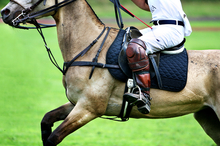Equine juvenile arthritis defined
Juvenile Arthritis is an inflammation and degeneration within a joint, involving the structures forming the joint, including the cartilage, capsule, bones, and ligaments in a horse that is usually between one and four years old. Care must be taken with younger horses to not overly stress these structures to avoid the development of juvenile arthritis.
What to look for:
- Pain, stiffness, and swelling around joints
- Redness or increased warmth around joints
- Appearance of bumps or swellings on the extremities
- Exercise intolerance
Causes of equine juvenile arthritis
- Damage to cartilage or bone because of continued concussion or injury
- Rapid growth spurts
Arthritis occurs when interference between the normal structure and function of the joint occurs. Damage to the cartilage or bone through injury results in a roughening of the smooth surfaces, which leads to inflammation. Inflammation produces chemicals that damage the synovial fluid, leading to swelling of the joint, which, in turn, results in pain and restriction of movement.
Injury to the joint capsule and its ligaments also trigger inflammation, resulting in thickening of the capsule, reducing its elasticity and causing the joint fluid to thin, which reduces its lubricating ability.
When a joint is subjected to repeated stress or trauma, such as can occur with everyday riding, training, or racing, damage of the synovial membrane and joint capsule are often the result. The damage may not be apparent immediately, but damage to the tissue allows white blood cells to escape and invade the joint space.
White blood cells release destructive substances that degrade the cartilage, causing the synovial fluid to become thin and watery. If left untreated, the joint damage progresses to arthritis.
The condition becomes chronic when new bone is formed in response to damage to the bone structure. The new bone is rough and does not have the usual covering of protective cartilage. The lack of protective cartilage leads to more pain, inflammation, and restriction of movement, as the condition advances to become chronic arthritis.

Working young horses at risk
Young horses subject to excessive work are at risk of developing juvenile arthritis.
Arthritis can also be the result of young horses rapidly gaining too much weight, which places stress on their bones and joints. When the suckling foal becomes a weanling, chances are that a decrease in growth rate will occur as the young horse adjusts to a diet without the mare's milk. Once the adjustment is made, young horses develop a tendency to overeat, leading to a rapid growth spurt.
Research indicates that it is important for the suckling to become accustomed to eating some grain before it is completely weaned. If not, a compensatory growth spurt may occur when the weanling begins eating grain. This can lead to a functional deficiency in the musculoskeletal system because it has not had time to develop well enough to carry additional weight.
Young horse's weight should be monitored to prevent excessive gains that may put the growing horse at risk for developing bone abnormalities and long-lasting skeletal problems that may lead to arthritis.
Treatment
Diagnosis and treatment is a job for your veterinarian, but initial treatment usually involves rest, along with topical liniments, such as DMSO, or more powerful anti-inflammatory drugs, such as Bute, to relieve swelling and pain.
Corticosteroids may be injected into the injured joints to reduce inflammation and lameness, enabling the horse to return to training. Care should be taken to avoid excessive doses that may result in long-term devitalization and damage to the internal joint structures. Rest and other non-steroidal therapies should be used in conjunction with any corticosteroids.
If X-rays indicate joint capsule involvement, injections of hyaluronic acid may be recommended. Where cartilage damage is present, treatment with polysulfated glycosaminoglycans may be recommended along with appropriate rest.
Warm poultices and heat bandages help to reduce stiffness and increase mobility. Swimming has also been shown to help maintain fitness without putting pressure on arthritic joints.
Some veterinarians recommend surgery, followed by radiation therapy, when bone chips or other joint damage has occurred.
Any time you notice a problem with your young horse's joints and limbs, a thorough examination by a veterinarian and follow-through with prescribed treatment will help assure long, active, productive career.
Dig deeperTM
Learn more about corticosteroids and their use in equine health treatments.

